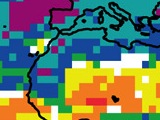Paul-Arthur Monerie’s PhD thesis
 The climate change effect on the african monsoon region: evolution of the precipitations and atmospheric fields in the CMIP3 and CMIP5 simulations under the A1B and rcp4.5 scenario. (1960-1999, 2031-2070)
The climate change effect on the african monsoon region: evolution of the precipitations and atmospheric fields in the CMIP3 and CMIP5 simulations under the A1B and rcp4.5 scenario. (1960-1999, 2031-2070)
Defended on the 18th June 2013
Abstract
The fourth IPCC report in 2007 established the synthesis of previously published work on the effects of climate change on global and regional scales. It shows in particular that no consensus can be found with regard to the future of rainfall — and atmospheric dynamics- associated with region — African monsoon. This dissertation revisits this issue in the light of new data and using an approach avoiding over-representation of the number of simulations available for one type of model and taking into account the diversity of models and their evolution in time: twenty general circulation models (GCMs) participating in the exercises CMIP3 (twelve GCMs) and CMIP5 (eight GCMs) under the A1B emissions scenario and rcp4.5, respectively. Outputs are analyzed on two 40-year periods, — ‘Present’ (1960-1999) and ‘Future’ (2031-2070) — and discussed in terms of likelihood, through an approach allowing us to both quantify differences ‘future’ minus ‘present’, measure robustness and statistical significances and associate a probability measuring the model consensus as a function of scales and variables.
Analyzes conducted on CMIP3 and CMIP5 show that consensus on the effect of climate change in West Africa can be achieved if we do not consider the Sahel as a whole and homogeneous entity but at lower scales. The results show contrasted responses over the central and western Sahel, with for the future, (i) an increase in precipitation in the central region explained primarily by a greater convergence of flow in the lower layers and a most northerly monsoon penetration over the continent, (ii) a rainfall decrease in the western Sahel explained by increased Walker-type circulation, African easterly jet and mid-level subsidence. Moreover, we can expect a change in the mean annual cycle of the monsoon season with a delayed withdrawal linked to additional inputs of moisture from the Atlantic due to increasing thermal and moisture contrasts between ocean and continent but also to a stronger contribution of moisture fluxes in September and October from the Mediterranean into the Sahel.
Keywords
Climate Change, African Monsoon, Sahel, General Circulation Models, CMIP3, CMIP5, A1B and rcp45 emission scenarios
Jury
Bernard Fontaine: directeur
Pascal Roucou: codirecteur
Thierry Lebel: rapporteur
Benjamin Sultan: rapporteur
Paolo Ruti: examinateur
Serge Janicot: examinateur
- extrait:
- lien_externe:
- kc_data:
- a:8:{i:0;s:0:"";s:4:"mode";s:0:"";s:3:"css";s:0:"";s:9:"max_width";s:0:"";s:7:"classes";s:0:"";s:9:"thumbnail";s:0:"";s:9:"collapsed";s:0:"";s:9:"optimized";s:0:"";}
- kc_raw_content:
 The climate change effect on the african monsoon region: evolution of the precipitations and atmospheric fields in the CMIP3 and CMIP5 simulations under the A1B and rcp4.5 scenario. (1960-1999, 2031-2070)
The climate change effect on the african monsoon region: evolution of the precipitations and atmospheric fields in the CMIP3 and CMIP5 simulations under the A1B and rcp4.5 scenario. (1960-1999, 2031-2070)Defended on the 18th June 2013
Abstract
The fourth IPCC report in 2007 established the synthesis of previously published work on the effects of climate change on global and regional scales. It shows in particular that no consensus can be found with regard to the future of rainfall — and atmospheric dynamics- associated with region — African monsoon. This dissertation revisits this issue in the light of new data and using an approach avoiding over-representation of the number of simulations available for one type of model and taking into account the diversity of models and their evolution in time: twenty general circulation models (GCMs) participating in the exercises CMIP3 (twelve GCMs) and CMIP5 (eight GCMs) under the A1B emissions scenario and rcp4.5, respectively. Outputs are analyzed on two 40-year periods, — ‘Present’ (1960-1999) and ‘Future’ (2031-2070) — and discussed in terms of likelihood, through an approach allowing us to both quantify differences ‘future’ minus ‘present’, measure robustness and statistical significances and associate a probability measuring the model consensus as a function of scales and variables.
Analyzes conducted on CMIP3 and CMIP5 show that consensus on the effect of climate change in West Africa can be achieved if we do not consider the Sahel as a whole and homogeneous entity but at lower scales. The results show contrasted responses over the central and western Sahel, with for the future, (i) an increase in precipitation in the central region explained primarily by a greater convergence of flow in the lower layers and a most northerly monsoon penetration over the continent, (ii) a rainfall decrease in the western Sahel explained by increased Walker-type circulation, African easterly jet and mid-level subsidence. Moreover, we can expect a change in the mean annual cycle of the monsoon season with a delayed withdrawal linked to additional inputs of moisture from the Atlantic due to increasing thermal and moisture contrasts between ocean and continent but also to a stronger contribution of moisture fluxes in September and October from the Mediterranean into the Sahel.
Keywords
Climate Change, African Monsoon, Sahel, General Circulation Models, CMIP3, CMIP5, A1B and rcp45 emission scenarios
Jury
Bernard Fontaine: directeur
Pascal Roucou: codirecteur
Thierry Lebel: rapporteur
Benjamin Sultan: rapporteur
Paolo Ruti: examinateur
Serge Janicot: examinateur
